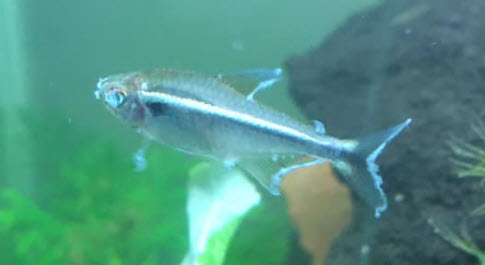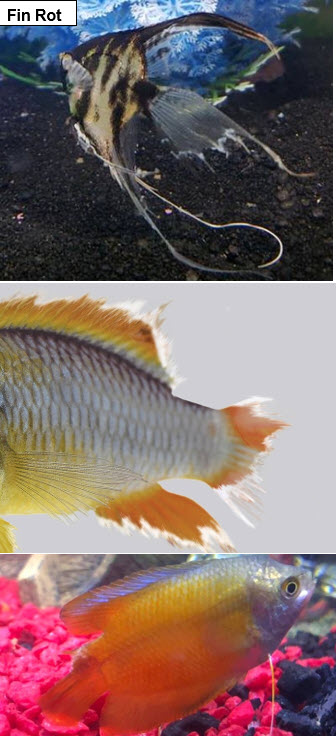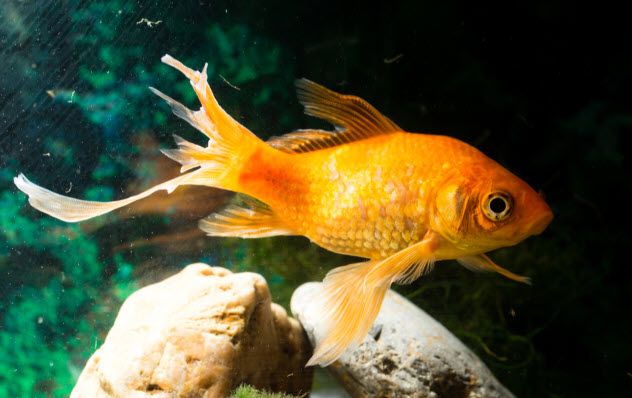
Fin rot is when the fins of a fish start eroding. Typically the eroding fins will have white edges. If white edges aren’t present it could be fin nipping and aggression which has caused the problem.

This is most often gram-negative bacteria (columnaris, aeromonas, etc.).
Treatment
Fin rot should be treated with broad spectrum antibiotics (Thomas Labs Fish Mox, Midland Vet Service Aqua-Mox, VetDepot Amoxicillin, Fishbiotic Ampicillin, Mardel Maracyn 2, SeaChem KanaPlex, Thomas Labs Fish Min, API Fin And Body Cure and Thomas Labs Fish Doxy). These antibiotics ONLY work when mixed into the food. They do NOT work when put into the water of the aquarium.
It is easy to make medicated food. Heat 1/4 cup water (two ounces or 58 milliliters, not a lot) in the microwave. Then blend seven grams of plain animal derived gelatin (Knox gelatin, one packet) into the hot solution with vigorous stirring. Take two tablespoons of dry commercial fish food (pellets or flake) and mix it with just a little of the hot water/ gelatin mixture. Add hot water/gelatin until you get a paste like consistency. If it gets too watery just add more food. To get gel food to float simply mix in a little whipped cream at this point.

Then add just a “smidgen” (roughly 1/16 teaspoon, a 1% to 2% addition) of medication to the mud. If you are using more than one medication mix the medications together, then use just a “smidgen” of the mixture. If you are using a packet of medication, take just a “smidgen” of the packet contents. Mix and mash the whole mass thoroughly. Spread it out into a pancake about 1/8th inch (3 mm) thick on a plastic film or a plate. Then put in the refrigerator. If you plan on keeping it for more than two weeks put it in a small plastic bag and freeze.
All the fish in the aquarium should be fed a steady diet of the antibiotic laced food for at least ten days. Note that the exact amount of medication which goes into the food is not very important. Antibiotics can be overdosed pretty much with abandon as they are only toxic in large doses over a period of months.
Note antibiotics in the food do not affect the filters so they can be left in place and operating.
If you can’t resist the urge to treat the water, remove the biofiltration media (including sponge and/or foam) in the filters and put it in an open container for the duration of the treatment. Sometimes antibiotics kill the beneficial bacteria and sometimes they don’t. In any case the filter media will denature the antibiotics. Monitor the ammonia and would do a 50% water change if it spikes above 1 ppm. Reduce the amount of food fed by 2/3 rds.
Note that if antibiotics are not available (i.e. in Europe or Canada), it is quite easy to take a pill or capsule of human antibiotic and use it for fish. If it is a pill just grind it up. Just be aware that the human antibiotics are about ten times more potent than the aquarium antibiotics, so just a “smidgen” in the food is more than enough. This is a very good option for the folks in Europe or Canada, where fish antibiotics are illegal.

If one has more than one fish with a bacterial disease, one must treat the whole aquarium. This is an emergency. Don’t fool around with herbs, tree leaf oils or some ineffective treatment. Ben Ochart treated a bacterial infection with Pimafix and Melafix. They did nothing to stop the infection. He lost a lot of large beautiful fish before he stopped the infection with antibiotics. This link covers the snake oil medications such as Melafix and Pimafix:
12.4.1. Natural Medications
It is very common when fin rot presents itself to also have a grey colored organism on the fish which looks somewhat like ich or sometimes a fungus. This is a common aquarium denizen which feeds off the bacteria being shed by the fin rot. It is called epistylus and here is a link to more information on it:
10.2.4. Epistylus
The entire topic of bacterial infections in tropical aquarium fish is covered in more detail in this link:
10.3.11. Treating Bacteria
Return to Diseases Menu
Return to Bacterial Menu
.
Aquarium Science Website
The chapters shown below or on the right side in maroon lead to close to 400 articles on all aspects of keeping a freshwater aquarium. These articles have NO links to profit making sites and are thus unbiased in their recommendations, unlike all the for-profit sites you will find with Google. Bookmark and browse!
.

Dave says
In reply to Angela …. Yes, bacterial infections can just “pop up” in any aquarium at any time.
Angela says
Thank you so much for the info. You saved my fish multiple times with your advice, especially on how to make medicated fish food!
My harlequin rasboras suddenly started dropping one by one. I was able to save some of them with kanaplex in their food as they did exhibit fin rot. However, I don’t know where the disease came from as I haven’t added anything new to the tank for over a year. Do bacterial infections just show up randomly in a tank without any changes that were made?
Jessica says
Thank you Dave. My beta is somehow still kicking! I have started the medicated fish food again, unfortunately now he seems to be slowly declining now. He’s been hiding a lot more than he used to inside his rock hideouts. He’s basically on hospice care until I see he’s suffering.
Dave says
JL …. I disagree. There is blood supply all the way out into the fins. One can see the capillaries under a microscope.
JL says
Hello Dave, I’ve been trying to understand how to treat fin rot and I’m getting varying advice. According to this fish vet, “Antibiotic treatment is rarely recommended for fin rot since it is hard to deliver immune factors to the end of the fins.” https://cafishvet.com/fish-health-disease/fin-rot-in-pet-fish/
What do you say?
Dave says
In reply to Alex … “Correlation does not imply causation”. You now need to switch to a food with a true antibiotic in it (something like Maracyn 2).The white on the food probably is harmless. Note that bettas are a short lived fish (typically two to three years) which commonly goes into a slow decline before death. So keep up with the antibiotic laced food but don’t be surprised if the betta doesn’t make it.
Alex says
Hi Dave. My betta’s been started growing jagged recently, after I finished medicating with Metroplex through food.
I noticed near the end of the treatment (17th day), the food started growing white stuff on it. I thought it was just Metroplex powder, but it became apparent it’s “water mold”. If that is secondary to bacteria, then I assume there’s a lot of bacteria in the food, which I had fed to my betta. Could this have caused fin rot? There are no white edges, but the timing is too close. My water is crystal clear, or close to it.
Dave says
Jessica ….. Bettas are a short lived fish (typically two to three years) which commonly goes into a slow decline before death. So keep up with the antibiotic laced food but don’t be surprised if the betta doesn’t make it.
Jessica says
Hello! I have a Betta fish that’s been fighting fin rot for the last 3 months. It was due to a plant having a sharp edge (I have now removed everything sharp and checked over everything in the tank). I had originally treated with very clean water, then when it got infected I treated with kanaplex in food for 2 whole weeks, clean water and added Seachem Stresguard. No change. I took a week off of antibiotics, made new food and tried again for another 10 days. No change. I took another week off with only clean water, then tried Seachem Paraguard, then All in one treatment from Tetra Lifeguard. I’ve now been trying salt baths every day with a water change and still Seachem Stressguard. I’m not seeing any change except it’s progressing very slowly. What else can I do?? Should I try medicated food again??